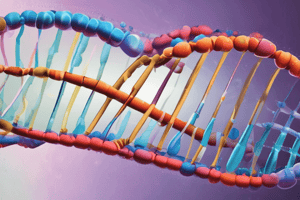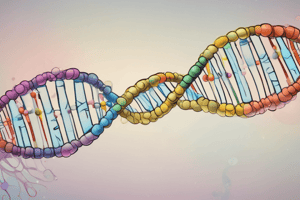Podcast
Questions and Answers
During DNA replication, which enzyme is responsible for sealing the gaps between newly synthesized DNA fragments?
During DNA replication, which enzyme is responsible for sealing the gaps between newly synthesized DNA fragments?
- Helicase
- Ligase (correct)
- DNA Polymerase
- Primase
Which type of mutation results in a change in the amino acid sequence of a protein?
Which type of mutation results in a change in the amino acid sequence of a protein?
- Frameshift Mutation
- Missense Mutation (correct)
- Nonsense Mutation
- Silent Mutation
During meiosis, at what stage does crossing over occur, leading to increased genetic variation?
During meiosis, at what stage does crossing over occur, leading to increased genetic variation?
- Metaphase I
- Telophase II
- Prophase I (correct)
- Anaphase II
Which of the following represents the correct sequence of sperm's journey through the male reproductive system?
Which of the following represents the correct sequence of sperm's journey through the male reproductive system?
What is the primary role of the seminal vesicles in the male reproductive system?
What is the primary role of the seminal vesicles in the male reproductive system?
Which of the following is a function of ribosomal RNA (rRNA)?
Which of the following is a function of ribosomal RNA (rRNA)?
During which trimester of pregnancy does organogenesis primarily occur?
During which trimester of pregnancy does organogenesis primarily occur?
Which of the following statements accurately describes the Law of Independent Assortment?
Which of the following statements accurately describes the Law of Independent Assortment?
In the context of Mendelian genetics, what does it mean for an individual to be heterozygous for a particular trait?
In the context of Mendelian genetics, what does it mean for an individual to be heterozygous for a particular trait?
What is the direct result of a nonsense mutation in a gene?
What is the direct result of a nonsense mutation in a gene?
How does RNA differ structurally from DNA?
How does RNA differ structurally from DNA?
What is the function of tRNA in translation?
What is the function of tRNA in translation?
If a diploid cell has 20 chromosomes, how many chromosomes will each haploid daughter cell have after meiosis?
If a diploid cell has 20 chromosomes, how many chromosomes will each haploid daughter cell have after meiosis?
What is the correct order of the developmental stages?
What is the correct order of the developmental stages?
What is the role of DNA polymerase in DNA replication?
What is the role of DNA polymerase in DNA replication?
Flashcards
Gene
Gene
A segment of DNA containing instructions to make proteins that determine traits.
Allele
Allele
Different versions of a gene, leading to variations in a trait.
Function of Nucleic Acids
Function of Nucleic Acids
Stores and transfers genetic information; guides protein synthesis.
DNA Molecule Structure
DNA Molecule Structure
Signup and view all the flashcards
DNA Base Pairing Rules
DNA Base Pairing Rules
Signup and view all the flashcards
Steps of DNA Replication
Steps of DNA Replication
Signup and view all the flashcards
mRNA (Messenger RNA)
mRNA (Messenger RNA)
Signup and view all the flashcards
tRNA (Transfer RNA)
tRNA (Transfer RNA)
Signup and view all the flashcards
Central Dogma of Molecular Biology
Central Dogma of Molecular Biology
Signup and view all the flashcards
Mutations
Mutations
Signup and view all the flashcards
Silent Mutation
Silent Mutation
Signup and view all the flashcards
Missense Mutation
Missense Mutation
Signup and view all the flashcards
Nonsense Mutation
Nonsense Mutation
Signup and view all the flashcards
Purpose of Meiosis
Purpose of Meiosis
Signup and view all the flashcards
Crossing Over
Crossing Over
Signup and view all the flashcards
Study Notes
- Study notes on Genetics and Molecular Biology
Gene & Allele
- Genes are segments of DNA contain instructions for making proteins that determine traits.
- Alleles are different versions of a gene that result in variations of a trait.
Nucleic Acids
- Nucleic acids consist of a sugar (deoxyribose in DNA, ribose in RNA), a phosphate group, and a nitrogenous base (A, T/U, G, C).
- Nucleic acids store and transfer genetic information and guide protein synthesis.
DNA Molecule
- DNA has a double helix structure composed of two strands.
- The sugar-phosphate backbone provides stability, while nitrogenous bases (A-T, G-C) are held together by hydrogen bonds.
- Adenine (A) pairs with Thymine (T) in DNA, while Guanine (G) pairs with Cytosine (C).
- In RNA, Uracil (U) replaces Thymine (T).
DNA Replication & Repair
- Helicase unzips the DNA strands during DNA replication.
- DNA polymerase adds complementary bases.
- Ligase seals the gaps between newly formed DNA fragments.
- DNA polymerase proofreads to fix mistakes.
- Mismatch repair corrects incorrectly paired bases.
- Excision repair removes and replaces damaged DNA segments.
RNA Molecule
- RNA plays a role in protein synthesis.
- mRNA (messenger RNA) carries genetic information from DNA to the ribosome.
- tRNA (transfer RNA) brings amino acids to the ribosome for protein assembly.
- rRNA (ribosomal RNA) helps form ribosomes and catalyzes protein synthesis.
- RNA is single-stranded, uses uracil (U) instead of thymine (T), and contains ribose sugar instead of deoxyribose.
Central Dogma of Molecular Biology
- Transcription (DNA → mRNA) occurs in the nucleus.
- RNA polymerase reads DNA and creates a complementary mRNA strand during transcription.
- Translation (mRNA → Protein) occurs in the ribosome.
- Ribosomes read the mRNA and use tRNA to assemble amino acids into proteins during translation.
Mutations
- Mutations are permanent changes in DNA sequence.
- Silent mutations have no change in the protein.
- Missense mutations change one amino acid, possibly altering protein function.
- Nonsense mutations create a premature stop codon, resulting in a shortened protein.
- Insertions add one or more nucleotides, while deletions lose one or more nucleotides.
- Frameshift mutations shift the reading frame, often causing major changes.
Meiosis
- Meiosis occurs in the testes to produce sperm in males and in the ovaries to produce eggs in females.
- Meiosis reduces chromosome number by half (from diploid to haploid) to ensure genetic diversity.
Key Concepts
- Haploid (n) is one set of chromosomes (gametes).
- Diploid (2n) is two sets of chromosomes (body cells).
- Sister chromatids are identical copies of the same chromosome, connected at the centromere.
- Homologous chromosomes are a pair of chromosomes (one from each parent) with genes for the same traits.
- Crossing over, occurring during Prophase I, is the exchange of genetic material between homologous chromosomes.
Steps of Meiosis
- Chromosomes condense, homologous pairs form, and crossing over occurs during Prophase I.
- Homologous chromosomes line up in the center of the cell during Metaphase I.
- Homologous chromosomes separate and move to opposite poles during Anaphase I.
- Two haploid cells form during Telophase I.
- Chromosomes condense again during Prophase II.
- Chromosomes align in the middle during Metaphase II.
- Sister chromatids are pulled apart during Anaphase II.
- Four haploid daughter cells form during Telophase II.
Meiosis in Males vs. Females
- Meiosis in males produces four sperm cells.
- Meiosis in females produces one egg and three polar bodies.
Reproduction & Development
- Study notes for the processes of reproduction and development
Male Reproductive System
- The path of sperm is: Testes → Epididymis → Vas Deferens → Urethra.
- Seminal vesicles provide fructose for energy.
- The prostate gland produces alkaline fluid to neutralize acidity.
- The bulbourethral gland provides lubrication.
Female Reproductive System
- The path of eggs: Ovary → Fallopian tube → Uterus
Developmental Stages
- Cleavage is rapid cell division without growth.
- Blastula formation is where a hollow ball of cells form.
- Gastrulation is the formation of three germ layers.
- Neurulation leads to the development of the brain and spinal cord.
Pregnancy Trimesters
- Organ systems develop during the first trimester.
- Fetal growth and minor development happens during the second trimester.
- The nervous system and lungs mature during the third trimester.
Birth Process
- The cervix opens during dilation.
- The baby is delivered during expulsion.
- The placenta is expelled during the placental stage.
Mendelian Genetics
- Study notes on understanding Mendelian Genetics.
Key Terms
- Genotype means the genetic makeup (e.g., AA, Aa, aa).
- Phenotype is the physical expression of a trait.
- Homozygous means two identical alleles (AA or aa).
- Heterozygous means two different alleles (Aa).
- Dominant refers to a trait expressed if one allele is present.
- Recessive refers to a trait expressed only if both alleles are recessive.
Mendel’s Laws
- The law of segregation means that alleles separate during gamete formation.
- The law of independent assortment means that traits are inherited independently.
Studying That Suits You
Use AI to generate personalized quizzes and flashcards to suit your learning preferences.




